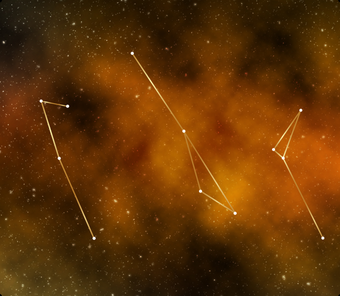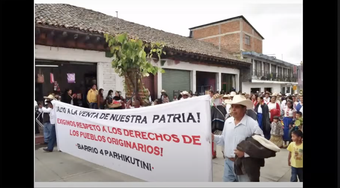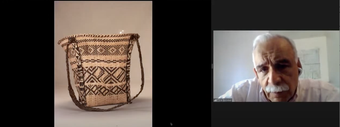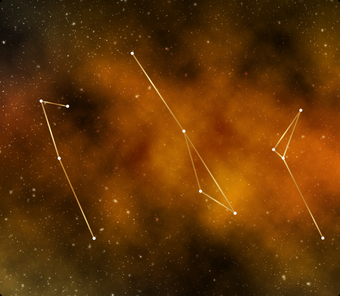
Courtesy of Museo Universitario Arte Contemporáneo (MUAC)
In each week of this online forum there was a keynote speech and a panel discussion, structured around one of the three thematic nodes: Geopoetics, Chronotopes and Enunciations. Accompanying each were essays written by the panellists and filmed visits to the studios of artists Manuel Antonio Pichillá, Tanya Lukin Linklater and Bernardo Oyarzún. All recordings and publications are available on the ‘Constellations’ website.
Talking about Indigenous art is not easy, especially within institutional spaces. Firstly, this is due to connections with histories of colonialism and capitalism, and in this sense institutions are in great debt to Indigenous peoples. This difficulty was further increased in this instance because Tate, a British institution, was one of the conveners. Secondly, due to the nature of neoliberal multiculturalism, the possibility quickly appeared of the subject being addressed as a new aesthetic category, condemning the conversation to just the surface of highly complex issues. And thirdly, because of the criteria for deciding who is given a voice in the discussion of these issues. However, the thematic nodes that articulated the discussions in ‘Constellations’ fostered reflection precisely from those difficult and uncomfortable zones, problematising them in an explicit manner, drawing out the area of concern that, in one way or another, underlies all the issues raised in the forum: ethics.
In this context, questions were asked about contemporary Indigenous art and the cultural and academic institutions that influenced its formation, considering their political backgrounds, their links to demands for autonomy, issues of exoticisation and homogenising definitions, the construction of false binaries, as well as the co-option of ancestral knowledge. The conversations took place among Indigenous, non-Indigenous and mestizo artists, curators and thinkers from both Latin America and English-speaking North America, all of whom offered a variety of critical perspectives from their practices and experiences in relation to Indigeneity and contemporary art.
Throughout the conversations there was agreement that the categories ‘Indigenous’, ‘art’ and ‘contemporary’ are Western conceptual constructions that have permeated the cultures of Indigenous peoples through contact with colonialism. Nevertheless, Indigenous communities have had the capacity to subvert these categories and appropriate them, engaging in a constant struggle to topple the narrative that denies contemporary Indigeneity, while neither neglecting the main differences nor the nuances that exist with Western cultures.

Screenshot from the online presentation given by the Cheraní Collective, as part of the digital forum ‘Constellations: Indigenous Contemporary Art from the Americas’.
Addressed in the Geopoetics node was the way the nation-state, as the predominant territorial organisation, meets resistance in well-articulated Indigenous communities that, through their own reference systems and in dialogue with the global contingency, strengthen local identities and fight for their territories. The central role of the community in Indigenous artistic practices was discussed by the Cheraní Collective, a group of Purépecha artists who shared the process of transforming their artistic work following a territorial defence movement, initiated in 2011, that led to the territorial and political autonomy of their community. For this collective, ‘being Indigenous is no longer understood in a colonial way’; the role of their work as artists is driven by both ancestral memory and the political contingency of their locality.
From another angle, the conflicts that arise within the discourse of colonial belonging were developed from experiences in institutional spaces in the panel titled ‘A Pluriverse at the Edges of the West’. The chief curator of the Museo Universitario del Chopo, Itzel Vargas, referred to Los huecos del agua. Arte actual de pueblos originarios, a curatorial project that sought to ‘break with the homogenising idea of the “Indigenous” as a cultural unit, without differences or particularities’ through a selection of works whose relationship to Indigeneity was based on self-identification, place of residence, birth or use of language.
Candice Hopkins, a curator and writer of Tlingit descent, focused her contribution on repatriation as a gesture of reparation, and art’s role in creatively challenging the limitations of repatriation. For Hopkins, museums operate as frameworks that transform Indigenous belongings by stripping them of their original contexts and functions, creating the problem of how to refocus agency on the belongings themselves once they are returned to their communities. In this context, she proposed the notion of ‘repatriation otherwise’, which aims to expand this process beyond the return of belongings, disrupting the protocols imposed by museums and seeking other ways of being with the objects.

Screenshot from the online keynote speech given by Ticio Escobar entitled ‘Indigenous Art Today: The Challenge of Concepts’, as part of the digital forum ‘Constellations: Indigenous Contemporary Art from the Americas’
The second node, Chronotopes, concerned the diversity and epistemic plurality of Indigenous peoples that challenges Western conceptual systems, especially the concept of progressive linear time that situates Indigenous cultures in the past. The contemporary, not only as a moment in time, but as a perspective that also contains diversity, was discussed by Ticio Escobar, curator and director of the Museo del Barro. For Escobar, dichotomies ‘do not let us think of more emancipated Indigenous forms’ and, therefore, the contemporary is an opportunity and a trap. This misunderstanding is, in many cases, the reason for isolating Indigenous cultures, but he noted that ‘cropping’ is not always justified.
The most profound reflection on circular time within Indigenous philosophy and practice was made by Métis artist and curator David Garneau in the panel titled Places of Time. As circular time has no beginning or end, he explained, ‘such a model centres the continuous present we actually experience’. In Indigenous art, ancestry and contemporaneity are intertwined, either using traditional forms to describe their current lives, or using contemporary media and aesthetics to refer to their traditions.
How does contemporary Indigeneity enter art museums that conventionally organise their collections according to progressive time? Researcher and curator Sharon Lerner presented her experience, advising the acquisition of works by artists from the Peruvian Amazon for the Lima Art Museum collection. Although the contemporary art collection makes no distinction between Indigenous and non-Indigenous art, she pointed out that institutions must assume their contradiction, to rethink the languages they operate with and use to mediate or transmit something that does not belong to them.
Lastly, Enunciations, the third node, examined the epistemic universes and ideological complicities involved in the production of theories and practices related to Indigeneity. The first was primarily addressed in the keynote speech by the Nahua artist and activist Fernando Palma, who presented a critical review of his artistic practice. A key aspect of his work is that it challenges the false Indigenous/technology dichotomy through its relationship with electronics, from a Nahua and quantum approach. Palma pointed out that, in the Nahua language ‘things’ are ‘people’, and that electronic technology ‘is also a person with whom we must dialogue’, not from merely a celebratory place, but that technology has to be humanised and we must examine the electronic world we have created. The main question is: under what lens?
The panel titled Knowledge and Worlding incisively elaborated on the critique of the ethical implications of academia in the production of knowledge on Indigeneity. The presentation by geographer and sound artist Anja Kanngieser and academic and Métis/Otipemisiw writer Zoe Todd principally debated the phenomenon of the ‘Indigenisation’ of institutions and the instrumentalization of communities in the field of environmental writing, where it is common to invoke conflicts in Indigenous territories and the epistemologies of their communities without having a relationship to them. ‘Environmental kin studies’ was proposed as an alternative: a practice focused on responsible and reciprocal relationships whose ethical compass places great value on acting with care.
From a perspective outside academia, Maya K’iche’ anthropologist and activist María Jacinta Xón Riquiac offered a critical analysis of the promotional poster for the Concert for Equality, an event in the framework of Tiempo de Mujeres, a gender equality festival in Mexico. On the poster, the name of Sara Curruchich, a Kakchickel Maya singer, appeared in much smaller print than those of two other artists, the Chilean singers Mon Laferte and Ana Tijoux – a distinction that went completely unnoticed by the organisers, the singers and the audience. For Xón Riquiac, this contradiction of promoting women’s equality while distinguishing them to advertise the event is proof that ‘diversity also normalises inequality’, and is evidence of the lack of self-criticism by spaces that are considered ‘diverse’. In this sense, she pointed out that academia and contemporary art are politically correct spaces that continue to describe difference as otherness, and that ‘everything that enters into contemporary art is complacent with this small, elitist, academic dissident sector… that is never going to leave the logics of capitalism’. Zoe Todd added, ‘contemporary art imagines itself as very radical, but the institutions that police it are very colonial and capitalist and white’.
These statements, although bleak for even the most optimistic, hold truth. Nonetheless, opportunities to reflect deeply, such as this, are appreciated because these institutions’ large platforms can contribute to amplifying crucial questions like those that arose in ‘Constellations’. Is it enough to just recognise the contradiction of cultural institutions in terms of their colonialist past and present? In a practical sense, to what extent can Indigenous cultures really circulate in contemporary art spaces without being displayed as ‘other’, and overcome the discourse of inclusion or forced translation that benefits those who categorise it as such? Furthermore, is it possible for institutions that operate on the basis of the categorisation of cultural productions to forge a permanent ethical relationship with a polyphonic Indigeneity, without breaking from the colonial and capitalist logics that mobilise them? Until this happens, the idea of Indigenous contemporary art will remain trapped in the space of the politically correct that serves capitalism so well.

